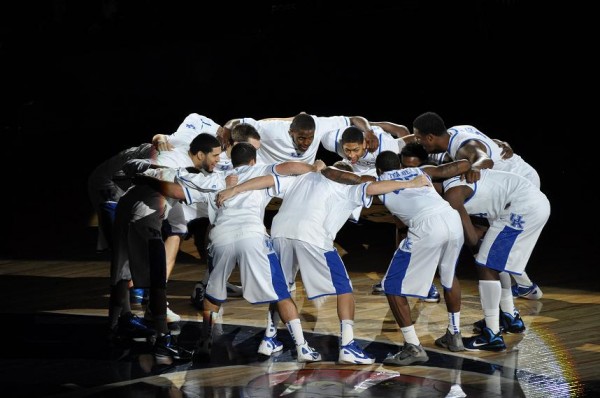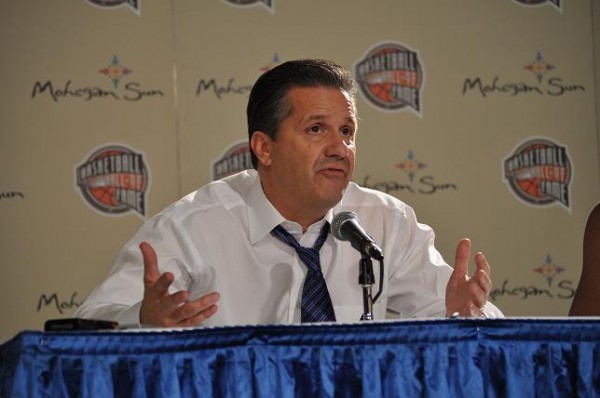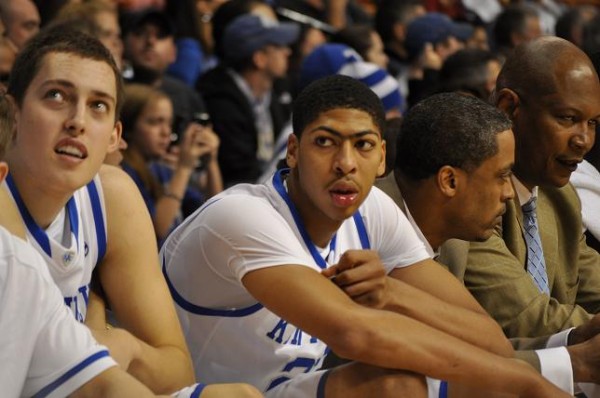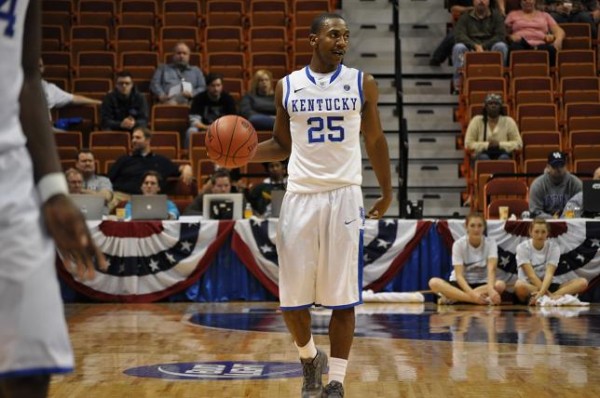Can Kentucky Become A Team? Does It Need To?
Posted by nvr1983 on November 23rd, 2011The old adage is that for many great teams the whole is greater than the sum of their parts, but for this year’s Kentucky team the opposite may be true. While John Calipari and the rest of Big Blue Nation hopes that this changes by the end of the season, the team’s performance early on indicates that this may not be the case. If the Wildcats continue to excel as individuals playing well in moments, but doing so inconsistently, the question is whether these Kentucky Wildcats are loaded enough to win a title by relying on their extraordinarily talented parts as opposed to becoming an efficiently functioning team. We have seen plenty of instances where supremely talented teams fail to live up to their potential because they rely on spectacular individual performances rather than cohesive play as a unit. However, few college basketball teams have boasted this amount of talent (all five Kentucky starters could be selected in next year’s NBA Lottery), particularly in an era where much of the top-level talent spends so little time in college.
The suggestion that the Wildcats function more as a talented group of individuals rather than a team should not be taken as a condemnation of Kentucky’s basketball team or John Calipari’s coaching methods even if some within the Big Blue Nation will take it as such. It is more a reflection of the extraordinary talent on this team and the lack of experience (outside of two seniors, the rotation is essentially two sophomores and four freshmen). You can make a compelling argument that the Wildcats still have ample time this season to come together as a team, but an equally compelling argument can be made that the skill sets of the players in their rotation tend to overlap so much that it is unrealistic for Calipari to put a rotation of his five best players on the floor and not have at least one of the players be somewhat redundant. As a result, it is unlikely that Kentucky will use all five players on the court at their optimal level, particularly on offense.
If Kentucky is on (even several players rather than as a team), there is not a team in the country that should beat them. They are simply too talented, too long, too athletic, and too quick for anyone else in the nation to beat if they play well. Of course, the Wildcats have vulnerable areas, like Old Dominion demonstrated when they threatened Kentucky late in the second half on Sunday, but that was more likely a reflection of the Wildcats’ sloppy play rather than some secret recipe for teams to knock off UK. If the Wildcats shoot poorly from the field and backslide into one of those ruts in which they turn the ball over every other possession, they are vulnerable — this has indeed happened on a couple of occasions so far — but so is every other basketball team ever assembled outside of the 1992 US Olympic Team.
My assertion that Kentucky functions more of a group of individuals rather than a team is not meant to imply that they do not play solid basketball, showboat too much, or look like an AAU team. On the defensive end, they are nothing short of spectacular with a nation-leading adjusted defensive efficiency of 84.6, and their opponents have an effective field goal percentage of 35.5% (seventh nationally). On the offensive end, they are nearly as good with an adjusted offensive efficiency of 118.4 (second nationally) and an effective field goal percentage of 58.8% (tenth nationally). When you actually watch them, though, you will see a team that relies on bursts of individual offensive excellence — only 54% of their made field goals come off assists, 146th nationally — rather than as a cohesive unit that only defers to the hot hand when necessary, as almost every team does. This inconsistency is apparent when you look at their regular rotation from top-to-bottom:
- Terrence Jones: Davis may be the most hyped player on Kentucky’s roster, but it is Jones who entered the season as the team’s top player after being named the SEC Preseason Player of the Year. Jones has neither lived up to the preseason accolades or come close to his spectacular early-season performance as a freshman; remember, he left Maui last November as a potential #1 overall pick on more than a few draft boards. Jones has shown flashes of brilliance, but he has disappeared for long stretches and has a tendency to overreact to situations. This was evident in the game against Old Dominion when he nearly got thrown out after a contentious sequence under the basket in the second half.
- Anthony Davis: Although he is the least offensively skilled of the Kentucky starters, Davis is probably the one opposing teams fear the most because his ridiculous combination of athleticism and wingspan make him a nightmare to guard and keep off the glass. As our SEC correspondent Gerald Smith noted, Kentucky airballs should be referred to lobs to Davis for the rest of his college career. Still, Davis is inconsistent at best on offense and tends to get lost when his more skilled teammates try to take over the games themselves. What Davis does already excel at is blocking shots (4.5 per game in just under 25 minutes per game this season) and putting the fear of God into the opposition during fast breaks both on the offensive and defensive end.
- Doron Lamb: Lamb is the least hyped of the starting five, but he has been the most consistent thus far. Outside of an eight point performance on Sunday against Old Dominion, Lamb has consistently been among Kentucky’s most productive players on the floor while continuing to be one of its most efficient, averaging 1.65 points per shot and 5.6 assists for every turnover. Lamb’s ability to spot up and his relative inability to create on his own (a liability that becomes an asset on a team full of players who can create on their own) may make him the most stable player on the roster.
- Michael Kidd-Gilchrist: The former #1 recruit in his class until he was overtaken by Davis and Austin Rivers, Kidd-Gilchrist has been one of the more surprising players for the Wildcats this year. Over the summer there was some talk that he might come off the bench to allow Miller to start, but Calipari appears to have made the right decision by getting the freshman involved in the game early and having the senior handle the more difficult role of coming off the bench. Honestly, when I watch Kidd-Gilchrist on the floor I see a shorter, less-temperamental version of Terrence Jones. Their stats so far this season support that. The way that Calipari handles the rotation of Kidd-Gilchrist and Miller could end up being a major factor in how good this team will be later in the season, because the former provides more talent while the latter offers more in terms of leadership.
- Marquis Teague: Calipari’s fifth straight starting freshman point guard has been the source of most of Calipari’s on-court criticism although Calipari has been quick to defend him when talking with the media. Teague has been alarmingly inconsistent at times and his decision-making could best be described as questionable in these admittedly early days. So far this season, Teague has just 11 assists against 18 turnovers and has made multiple poor decisions on fast breaks. He has shown his potential occasionally, but he has struggled the most out of any of the players in the regular rotation. However, history shows that Teague is not that far behind his predecessors at this point of the season. Still, Teague’s development may be the most important factor in determining whether this year’s Wildcats begin to function as a team or remain just an insanely talented group of individuals wearing the same jersey.
- Darius Miller: Miller, the senior leader of the team, has been fairly quiet this season with the exception of a big first half against Old Dominion that kept the Wildcats in the game before the rest of the team woke up to pull away at the end. Miller has found ways to contribute in other ways, averaging a team-leading 4.5 assists per game despite coming off the bench. Miller has had to subordinate his desire to become a focal point of the offense as a senior for the betterment of the team as a whole. He has shown that he can step up and score in spots, however, and is a solid outside shooter despite his poor start this season (1-8 from 3-point range).
- Kyle Wiltjer: An exceptionally skilled big man, he has the range to shoot from outside and the size to battle underneath. Wiltjer has been spectacular in games against Marist and Penn State, but has been silent in the team’s two more competitive games against Kansas and Old Dominion; this is probably a reflection of what Calipari thinks of Wiltjer’s defense at this point of his freshman year. Some people expect Wiltjer to get significant minutes, but with his porous defense and the talented big men on Kentucky’s roster, don’t expect Wiltjer to be logging significant minutes regularly in big games unless foul trouble or injuries force Calipari to pull the trigger.
- Eloy Vargas: The team’s lone traditional low-post player. In an ideal traditional basketball world, Vargas would get significant minutes for this team as a defender and rebounder, but his lack of offensive skills and questionable decision-making make him the last man in the rotation. If you want to argue otherwise, don’t forget that Calipari cut him from the Dominican Republic National Team over the summer. When your own coach doesn’t even want you as his twelfth man as a rising senior, it says a lot about what he thinks of your game.
The obvious question here is whether it is too early to judge a team with so many freshman, particularly a team that has crushed two of its four opponents and looked dominant for much of the second half against a team that will be playing in the Maui finals tonight. We will admit it is a fair point, and for most teams we would be willing to concede it. But as we said, the feel on this Kentucky squad is different so far, with talented all-court players that make the line-up almost appear too talented to function like you would expect a normal basketball team to do. There certainly have teams that possesed more talent, and, of those, some have won national titles, but you would be hard-pressed to find one with so many overlapping parts as this UK team.
The next question is whether is it too much to expect six players, much less eight, to contribute regularly. In the post-game press conferences, Calipari seemed to be OK with the variable offensive contributions as long as everybody played well on defense. This is a reasonable statement, and looking at the championship teams over the past 20 years, most of them relied on three or four players to contribute regularly on offense. Exceptions include last year’s Connecticut team and the 2003 Syracuse team, both of which largely relied on one player (Kemba Walker and Carmelo Anthony, respectively) for offense. This Kentucky team probably will not find those three or four players to regularly contribute, but might manage to find three or four different players who can contribute on a given night — not unlike the 1996 Wildcats.
The final question is which teams out there can beat these Wildcats. It is possible that a team similar to Old Dominion, which does not play right into Kentucky’s hands with its style of play, might be able to catch the Wildcats on a bad day and knock them off. As the season progresses and the Wildcats become more comfortable playing with each other, though, that will become increasingly unlikely. Their most likely challengers are North Carolina, Connecticut, and Ohio State, three teams with a solid inside presence that could exploit Kentucky’s biggest weakness. All three teams – particularly the first two — could pose significant obstacles for the Wildcats, but to borrow a technique from Calipari we could just as easily point to a number of reasons why those teams would have difficulty matching up against the Wildcats. If the Wildcats are firing on all cylinders, we would have a hard time picking against them. Still, as we have seen countless times, it only takes one off-night for a team, or one opponent shooting the lights out to eliminate a potential juggernaut. If the Wildcats are able to win and do so in the manner that they have been playing this season, they may go down as the first champion that we can remember that relied on random individuals to step up each game rather than one that exhibited more traditional roles for its players, especially on the offensive end.















































I think the lack of “team” is more attributed to a freshman point guard who has struggled early on. Teague has very few assists and has struggled running the offense. Once he comes along (which he will in due time), this UK team will look more like a well oiled machine.
Glad you can simply give Teague the whole “which he will” treatment since this team BADLY needs a point guard to get the three forwards buckets. Like the article said, Jones and Gilchrist are remarkably similar players, which means in part they have a tendency to force shots and take blah 3s, even though they (and Davis too) have overwhelming physical skills and could dominate with looks in the lane if they had someone getting them the ball in the right spot.
Combine that with the lack of a backup point guard, and instead having to shoehorn Lamb into that role, along with Miller trying to work as a ball-handling offguard (and if any of those three get hurt, oooh boy) expect bad-shot vigilantes like Knight and Dickie V to cringe through every big Kentucky game.
Who can beat them? I can see them losing two different games – a low-turnover team who goes halfcourt and takes better shots, or a high-scoring club who wins when Kentucky just blows too many possessions.
Unless Teague gets better in due time, which had better be less than four months.
I think we’re essentially saying the same thing, I am just way more confident in Teague’s abilities. Teague is now five games into his college basketball career, and his fifth game produced 5 assists and just 2 turnovers. Both John Wall and Brandon Knight were erratic running the offense, played selfishly and turned the ball over often in their first several games at UK. They developed under Calipari (in due time). Talented freshmen will adjust to the speed of the college game. It just takes time. But yes, I think he will adjust, and I think he’ll do it quickly.
“Both John Wall and Brandon Knight…developed under Calipari (in due time)”
Sure, they developed, but I don’t think they developed in one year into the kind of point guard that can lead a team to a national championship.
To win it all, you have to win 6 straight games. So, you have to be consistent enough that your team doesn’t have a bad game against 6 straight opponents that range from decent to excellent.
First, realize that, even looking at the best high school players, not all of them are able to adjust and thrive within their first year. Great coaching can help that development, but some kids just take longer.
Second, thriving is not the same as being consistent. I think consistency is much harder to develop, and a lot of great players don’t develop that in their entire college career, let alone in their first year.
Teague is likely to figure it out this year, settle down, and become an excellent point guard by the end of the year. But I think the chances are very slim that he will develop into a player that can lead and manage his team to a championship.
I think the argument of the article is that maybe this team is so talented that they don’t need to be lead to win it all. I think that’s pretty unlikely.